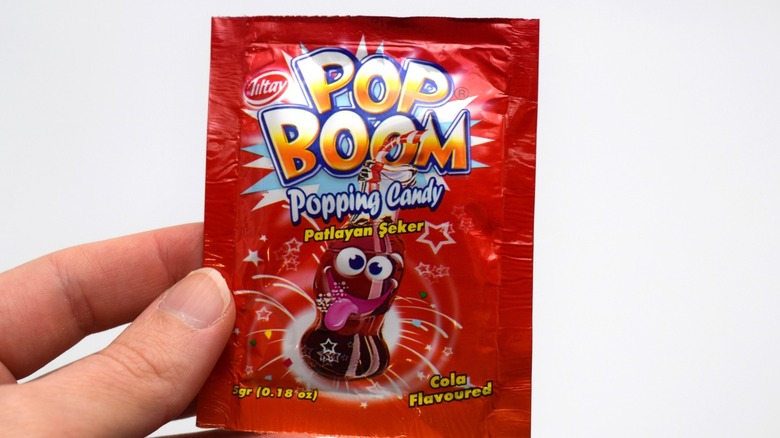How Pop Rocks Candy Works, According To Science
We may receive a commission on purchases made from links.
There's no doubt that candy makes you feel good when you eat it. It's one of the most enjoyable foods in the world. Popping candy, such as Pop Rocks, adds a whole new layer of fun. Even the best chefs will tell you that when you can incorporate the other senses into a dish, you transform it from the mundane into something extraordinary. It becomes an experience. So, the fact that Pop Rocks have that sweet taste, the popping sensation you can feel on your tongue, and the sound to go with it really makes it stand out in the candy world.
The secret behind how Pop Rocks work is carbon dioxide. Pop Rocks were invented by the same chemist who invented Cool Whip and Tang. According to the patent he filed in 1959, popping candy works by trapping carbon dioxide inside melted sugar under high pressure. The result stays stable at room temperature until the sugar gets wet, which it does in your mouth or when used as a garnish in a drink, and starts to dissolve, releasing the gas bubbles.
The reason the reaction is so explosive, albeit tiny, is because the carbon dioxide gas is under pressure inside the sugar. Your saliva weakens that sugary shell to the point that it can't hold together anymore. This is why it makes a noise when it dissolves. The popping pressure causes little explosions in your mouth that you can feel and hear.
The history of Pop Rocks
Pop Rocks were invented by accident. When chemist William Mitchell was trying to invent an instant carbonated soft drink mixture, he stumbled upon the formula for popping candy. He didn't create instant soda, but his invention did have merit. It ended up pretty high on our list of classic Halloween candies for a reason.
Throughout the 1970s, Pop Rocks generated hundreds of millions of dollars in sales. It's hard to overstate the candy's popularity. But a rumor that the child actor who played Mikey in the Life cereal commercial died after consuming Pop Rocks and Coca-Cola actually had a devastating effect on sales.
Despite a publicity campaign to prove the candy was safe, which included the actor who played Mikey proving he was still alive, General Mills was unable to overcome the rumors that destroyed Pop Rocks. They discontinued the candy in 1982. Just a few years later the rights were bought by another company and Pop Rocks were back on shelves by 1987 and you can still get Pop Rocks today.
It is possible to make a homemade version of Pop Rocks with baking soda, sugar, and citric acid, but it won't be quite as good as the real thing. Most of us are unable to mix pressurized gas and hot sugar at home, so the genuine article is out of reach. Food and science have long gone hand in hand, and Pop Rocks are just one more example of the fun ways they interact.

